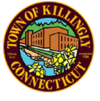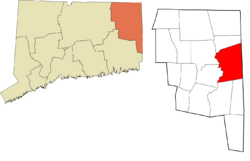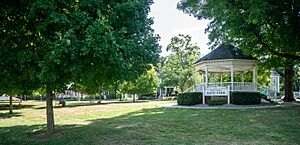Killingly, Connecticut facts for kids
Quick facts for kids
Killingly, Connecticut
|
||
|---|---|---|
| Town of Killingly | ||
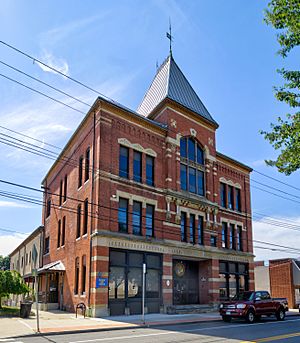
Killingly Town Hall
|
||
|
||
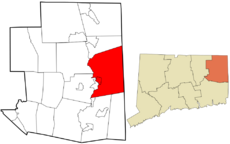 Windham County and Connecticut Windham County and Connecticut |
||
| Country | ||
| U.S. state | ||
| County | Windham | |
| Region | Northeastern CT | |
| Incorporated | 1708 | |
| Government | ||
| • Type | Council-manager | |
| Area | ||
| • Total | 50.0 sq mi (129.5 km2) | |
| • Land | 48.5 sq mi (125.7 km2) | |
| • Water | 1.5 sq mi (3.8 km2) | |
| Elevation | 449 ft (137 m) | |
| Population
(2020)
|
||
| • Total | 17,752 | |
| • Density | 366/sq mi (141.2/km2) | |
| Time zone | UTC-5 (Eastern) | |
| • Summer (DST) | UTC-4 (Eastern) | |
| ZIP code |
06239, 06241, 06243
|
|
| Area code(s) | 860/959 | |
| FIPS code | 09-40500 | |
| GNIS feature ID | 0213447 | |
| Historical population | |||
|---|---|---|---|
| Census | Pop. | %± | |
| 1820 | 2,803 | — | |
| 1840 | 3,685 | — | |
| 1850 | 4,543 | 23.3% | |
| 1860 | 4,926 | 8.4% | |
| 1870 | 5,712 | 16.0% | |
| 1880 | 6,921 | 21.2% | |
| 1890 | 7,027 | 1.5% | |
| 1900 | 6,835 | −2.7% | |
| 1910 | 6,564 | −4.0% | |
| 1920 | 8,178 | 24.6% | |
| 1930 | 8,852 | 8.2% | |
| 1940 | 9,547 | 7.9% | |
| 1950 | 10,015 | 4.9% | |
| 1960 | 11,298 | 12.8% | |
| 1970 | 13,573 | 20.1% | |
| 1980 | 14,519 | 7.0% | |
| 1990 | 15,889 | 9.4% | |
| 2000 | 16,472 | 3.7% | |
| 2010 | 17,370 | 5.5% | |
| 2020 | 17,752 | 2.2% | |
| US Decennial Census | |||
Killingly is a town located in Windham County, Connecticut, in the United States. It is the largest town by population in the Northeastern Connecticut Planning Region. In 2020, about 17,752 people lived there.
Killingly includes the area known as Danielson. It also has several smaller villages. These include Attawaugan, Ballouville, Dayville, East Killingly, Rogers, and South Killingly.
Contents
History of Killingly
Early Settlement and Naming
The land where Killingly now stands was first claimed in 1653. John Winthrop the Younger, whose father was a governor, received this land. It was once home to the Quinebaug Indian tribe. The name Quinebaug means "long pond" in the Native American language.
English settlers first arrived in this area around 1700. The place was initially called "Aspinock." This name might have come from a Native American word combined with the name of an English settler, Lieutenant Aspinwall.
In May 1708, Killingly officially became a town. The governor at the time, Gurdon Saltonstall, suggested the name. He named it after places in Yorkshire, England, where his family came from. The spelling was later changed to Killingly.
Industrial Growth and Production
In the 1830s, Killingly was a major center for making cotton goods. Mills in the town used cotton from the southern United States to create textiles. This industry was very important to the town's economy.
By the 1930s, Killingly had changed its focus. It became well-known for producing window curtains. This shows how the town's industries adapted over time.
Geography of Killingly
Land and Water Areas
Killingly covers a total area of about 50 square miles (129.5 square kilometers). Most of this area, about 48.5 square miles (125.7 square kilometers), is land. The remaining 1.5 square miles (3.8 square kilometers) is water, making up about 3% of the town's total area.
Main Communities in Killingly
Killingly is made up of several distinct communities. Each has its own unique character.
- Attawaugan
- Ballouville
- Chestnut Hill
- Danielson (this is a borough, which is a type of self-governing community within a town)
- Dayville
- East Killingly
- Elmville
- Killingly Center
- Rogers
- South Killingly
Historic Places in Killingly
Many places in Killingly are listed on the National Register of Historic Places. This means they are important historical sites. They are protected to help preserve their history for future generations.
- Broad Street – Davis Park Historic District – This area includes buildings along Broad Street. It was added to the list in 1998.
- Daniel's Village Archeological Site – An important site for studying the past, added in 1978.
- Danielson Main Street Historic District – Features buildings with older styles like Colonial Revival. Added in 1992.
- Dayville Historic District – Includes historic buildings on Main and Pleasant Streets. Added in 1988.
- Elliottville Lower Mill – An old mill located on Peep Toad Road. Added in 1982.
- Old Killingly High School – The former high school building at 185 Broad Street. Added in 1992.
- Temple Beth Israel – A historic religious building at 39 Killingly Drive. Added in 2003.
Population and People
In 2010, Killingly had 17,370 people living there. The population density was about 358 people per square mile. Most of the people living in Killingly are White. There are also smaller groups of African American, Native American, and Asian residents.
Killingly is home to a small Laotian community. Both Danielson and Killingly are among the top 50 cities in the U.S. with the highest percentage of people who have Laotian family roots.
The average household in Killingly had about 2.5 people. The average family had nearly 3 people. About 22% of the population was under 18 years old. Around 14% of the population was 65 years or older.
Transportation in Killingly
Air Travel
Danielson Airport is an airport located near Danielson, a borough in Killingly. It is owned by the state and is open for public use. The airport is about 2 nautical miles (4 kilometers) northwest of Danielson's main business area.
Bus Services
Bus service in the Killingly area is provided by the Northeastern Connecticut Transit District. This service helps people travel around the region without needing a car.
Notable People from Killingly
Many interesting people have connections to Killingly.
- Francis Alexander (1800–1881) was a portrait painter born in Killingly.
- Harriet Pritchard Arnold (1858–1901) was a writer.
- Manasseh Cutler (1742–1823) was a US representative, soldier, and scientist. He helped create the Northwest Ordinance of 1787 and founded Ohio University.
- John M. Dowe (1896–1946) served as the Connecticut State Comptroller.
- Frederick Delmont Chesbrough (1859-1943) invented the Warp Stop Motion for automated looms.
- William Torrey Harris (1835–1909) was a philosopher and educator. He started the first permanent kindergarten and was a U.S. Commissioner of Education. He was born in North Killingly.
- Mary Dixon Kies (1752–1837) was the first woman in the United States to receive a patent. She got it in 1809 for a new way to weave straw with silk or thread. She was born and lived in South Killingly.
- Samuel Knight (1731–1804) was a chief justice of the Vermont Supreme Court.
- Charles Tiffany (1812–1902) was born in Killingly. He later became the owner of the famous jewelry company, Tiffany and Company.
- Ebenezer Young (1783–1851) was a United States representative from Connecticut.
See also
 In Spanish: Killingly (Connecticut) para niños
In Spanish: Killingly (Connecticut) para niños


